The Truckers of Tomorrow
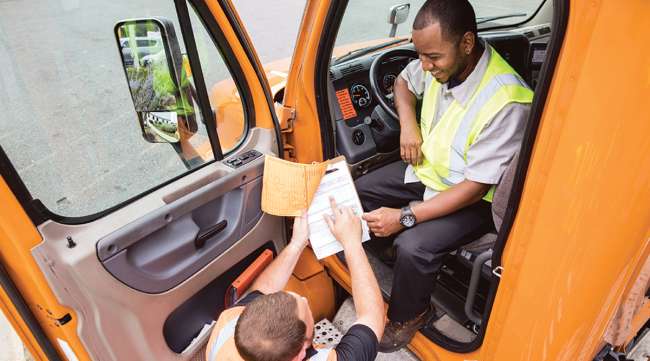
[Stay on top of transportation news: Get TTNews in your inbox.]
In the years ahead, the essential task of hauling the nation’s freight and keeping the economy rolling will increasingly shift to a new generation of professional truck drivers.
Attracting workers to step into those roles remains a long-standing challenge for trucking companies, but somehow fleets will need to bring in younger drivers to keep pace with projected freight growth and offset the wave of retirements headed their way as their existing workforce ages.
To accomplish this, fleet operators must find ways to recruit from a broader labor pool and meet the lifestyle preferences and work expectations of future drivers.
Several industry leaders said younger workers expect more from a driving career, including flexible schedules, a clear career path and a sense of belonging.
“Ultimately, it’s going to come down to culture, work-life balance and stability,” said Pat Udovich, chief human resources officer at less-than-truckload carrier A. Duie Pyle. “Culture has become king — rightfully so — and we do not see that changing as the next generation comes onboard.”
See the 2023 Top 100 rankings
►Growth Despite Softer Freight Market
►The Truckers of Tomorrow
►Taking Aim at the Parking Shortage
►Managing Regulatory Compliance
►Interactive Map
►Sector Rankings Show Growth, Acquisitions
Sector Rankings
LTL | TL/Dedicated
Intermodal/Drayage
Motor Vehicle/Driveaway
Tank/Bulk | Air/Expedited
Refrigerated | Flatbed/HS
Package/Courier | Mail
Household Goods/Commercial
On a list of drivers’ priorities, work-life balance has always been a close second to pay, but the younger generation is pushing that level of importance even higher.
“A growing percentage of candidates are even opting for lower-paying jobs with a larger amount of home time or flexibility in taking home time,” said Chris Polenz, vice president of recruiting at truckload carrier Werner Enterprises.
Fleets are adjusting their operations and implementing technology to help provide that flexibility.
Werner, for one, uses its mobile app to match drivers with their needs.
“We have a ‘career opportunities’ tab on our Driver Werner Pro App allowing drivers to search for existing accounts that meet their work-life balance,” Polenz said. “From there, they can select to be added to those wait lists or talk to a career center specialist at any time to discuss their requests.”
Werner, based in Omaha, Neb., ranks No. 17 on the Transport Topics Top 100 list of the largest for-hire carriers in North America.
Dee Dee Cox, vice president of human resources at Old Dominion Freight Line, said the LTL carrier has been getting more creative in planning its drivers’ schedules.
That requires open and honest communication regarding the company’s and employees’ needs, starting during the interview process, she said. “What is the driver looking for in the long term? Is it OK if the driver is off on Tuesday and Wednesday? Do those days actually work better for home life, or are they looking for a Saturday-Sunday reset?”
A. Duie Pyle offers LTL and dedicated driving jobs that help prospective candidates align with their schedules outside of work, Udovich said.
Getting home daily is a huge sell to many who want to be present for events outside of work, whether it’s their kid’s baseball game or high school graduation, he added.
A. Duie Pyle, based in West Chester, Pa., ranks No. 66 on the for-hire TT100 list.
Despite the push for more home time and flexibility, some young drivers don’t mind being out on the road for longer stretches.
Andy Turi, a 23-year-old driver who joined Brenny Transportation about a year ago, prefers to be on the road. Turi earned his commercial driver license at 18 and worked in regional operations until turning 21.
“Becoming an OTR driver became more enticing because I could live in my truck and get paid,” Turi said. “I have saved tens of thousands of dollars.”
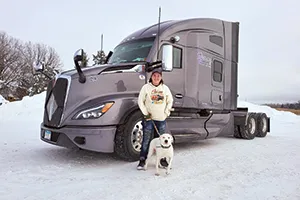
Andy Turi earned his CDL at 18 and worked in regional operations until turning 21.
While it was the pay that initially attracted him to the industry, his appreciation for trucking has expanded beyond that.
“I’m not doing it for the money anymore,” Turi said. “I like being by myself and getting paid to go places I haven’t been before.”
Garner Trucking, based in Findlay, Ohio, is primarily an over-the-road carrier whose drivers typically spend four to five days overnight in their trucks.
CEO Sherri Garner Brumbaugh said the company sometimes loses drivers to home-daily opportunities, but adjusting freight transportation networks, when possible, can boost retention.
“Relaying, slip seating OTR operations and drop-hook keep a driver moving and not sitting. Creativity many times brings efficiencies to your operation as well,” said Brumbaugh, who is a past chair of American Trucking Associations. “At Garner, we have multiple driving schedules an individual can choose from. Unlike my father’s generation that lived to work, this generation and mine is ‘work to live.’ ”
Pay remains a high priority for drivers, but Brumbaugh has found that experiences also matter to younger employees.
“The trucking industry should be able to provide both — good pay and the experience to see the country,” she said. “Marketing those stories is key.”
Attracting Younger Drivers
The average age of a new entrant into the trucking industry continues to hover between 35 and 38 years old, but younger people oftentimes are in a better position to take on longhaul jobs, said Jeremy Reymer, CEO of DriverReach, a provider of driver recruiting software.
“The best time for a worker’s willingness to be away from home for extended periods of time is when they’re young and have little to no responsibilities or other obligations that would otherwise preclude them from such a working dynamic,” Reymer said.
Brenny Transportation, which is based in St. Joseph, Minn., has focused on recruiting younger drivers and got involved with a young-driver training program through the Minnesota Trucking Association.
“We can bring them on locally at 18 years old until they’re of the age to leave the state,” said company founder and CEO Joyce Brenny, who emphasized the carrier’s safety rating and its slow, graduated training process.
Lowering the minimum age for interstate truck drivers from 21 to 18 also could bring more young people into the industry.
Garner Trucking’s Brumbaugh urged carriers to participate in the Federal Motor Carrier Safety Administration’s three-year Safe Driver Apprenticeship Pilot Program.
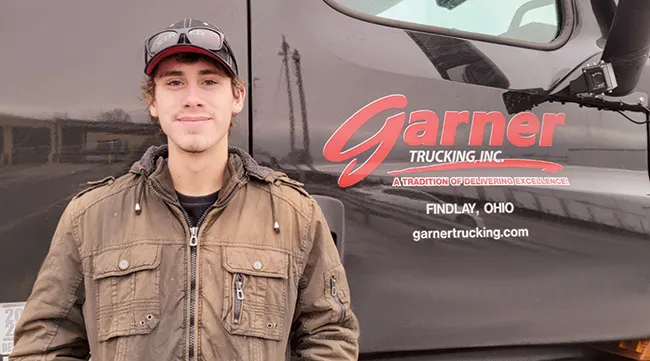
Jarod Vogel, 19, signed up for FMCSA’s Safe Driver Apprenticeship Pilot Program to work with Garner Trucking.
“The Infrastructure Investment and Jobs Act requires the FMCSA to establish an apprenticeship pilot program that would allow drivers between the ages of 18-20 with an intrastate commercial driver license to operate interstate, but it requires a trucking company to follow rigid rules to participate,” she said.
While becoming a participating carrier and apprentice trainer can be challenging, Brumbaugh said it is necessary.
“If we as an industry fail to participate, we will be the barrier ourselves to attracting a younger generation to our beloved trucking industry,” she said.
Lindsey Trent, president and co-founder of the Next Generation in Trucking Association, said the industry can’t wait until potential hires reach the age of 18. Instead, it has to find ways to engage young people early in their high school careers.
“They are getting bombarded from other industries — welding, plumbing and electricians — and trucking needs to be a part of the conversations too,” Trent said.
The Gen Z workforce is smaller, and skilled trade jobs are growing, she added. “Pair that with the aging workforce that is retiring, and that could equal disaster for our future.”
NextGen Trucking works with student organizations and presents trucking careers to school guidance counselors.
“We have careers that are high skill, high wage and high demand, but young people need to be educated about them in order to be attracted to them,” Trent said.
One of the challenges is that more teenagers are graduating from high school without a driver’s license.
“Acquiring a CDL builds upon an individual’s personal driving record,” Garner Trucking’s Brumbaugh said. “Trucking companies should work collaboratively with our communities to share the importance of obtaining a driver’s license.”
A More Diverse Workforce
Women can play a large part in expanding the industry’s labor pool.

Guy Broderick of Kriska shares how he successfully combined data reports and a simple understanding of human nature to become one of the best driver coaches in North America. Tune in above or by going to RoadSigns.ttnews.com.
Ellen Voie, founder of Women In Trucking, a nonprofit organization promoting opportunities for women in the transportation industry, said women represent nearly 14% of all over-the-road drivers, and she expects that number to increase.
“More and more women are seeing the opportunity to earn a middle-class income while being able to travel,” she said.
NextGen Trucking’s Trent said young people need to see female role models in trucking and know they are welcome in this industry.
“We need to actively put that messaging out there,” she said.
Attracting employees from across diverse demographics also can help strengthen the industry’s workforce.
“Every person can come into the trucking industry, and there should be no barriers because of gender, race or identity,” Garner Trucking’s Brumbaugh said.
Voie believes there will be more Hispanic drivers and more drivers from Eastern European countries.
“There have been a lot of refugees entering the country, and if we can embrace their customs and accommodate them, we can train them to become professional drivers,” she said.
Touting Technology
The advance of technology in the trucking industry can be a valuable tool for attracting new employees.
Old Dominion Freight Line emphasizes the technology installed in a modern truck when meeting with high school students and potential workers in Gen Z, Cox said.
“When we have on-site career fairs, it is important for potential hires to see the equipment they will be working with,” she said. “Once they see the technology, their eyes open up as this is not something they expected.”
ODFL, based in Thomasville, N.C., ranks No. 10 on the for-hire TT100.
Rich Johnson, vice president of school operations at Werner, said technology is a differentiator.
“The next generation has a higher expectation on how ‘connected’ they are to their company, whether it is company apps, in-cab communications or ways for family to stay connected with them while they are on the road,” he said.
Offering More Than a Job
Younger people are increasingly interested in career progression opportunities.
“Gen Z wants to see defined career paths and what you will do as a company to invest in your employees and their future,” NextGen Trucking’s Trent said. “Do you provide a mentorship program, ongoing training or tuition reimbursement? Gen Z wants to work for a company that cares about them and that will develop them.”
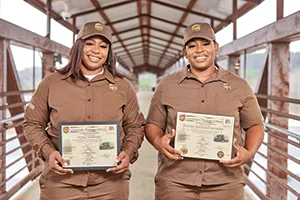
Alyssa and Brittney Strickland earned their CDLs while working at UPS and are now supervisors in its Class 8 operations.
Jim Mayer, senior director of media relations and network communications at UPS Inc., said the company fills most of its driver positions by training and promoting from within.
New employees typically are hired to handle packages in UPS facilities.
“After some time in that role, they can bid and train for full-time positions as drivers,” Mayer said. “For those who want to advance their career, the sky is the limit. Our previous CEO, David Abney, started his career loading trucks in Mississippi.”
UPS ranks No. 1 on the for-hire TT100.
Alyssa and Brittney Strickland, 30-year-old twin sisters, started with UPS handling packages and then earned their CDLs. Today they work for the company as supervisors within its Class 8 “feeder” operations.
“A lot of young people are willing to go into this area, but they don’t know about it,” Alyssa Strickland said, adding that 21-year-olds can take advantage of great opportunities immediately. “We give them that free training, and they can get their CDL.”
Two of A. Duie Pyle’s best recruiting tools are its truck driving academy and leadership development program.
“We want to give all our employees, not just drivers, the opportunity to continue to grow and expand their skill sets,” Udovich said.
Many of today’s drivers want a potential pathway to a career outside of the truck, such as in dispatch, maintenance, safety or some other management function, DriverReach’s Reymer explained.
Werner’s Polenz said many of Werner’s professional drivers have leveraged their driving experience into nondriving jobs in its safety and operations departments.
Having a CDL can add value to those in other positions.
“It is easier to dispatch when you know what is going on,” Brittney Strickland said. “A CDL is a great thing to have even if you don’t use it.”
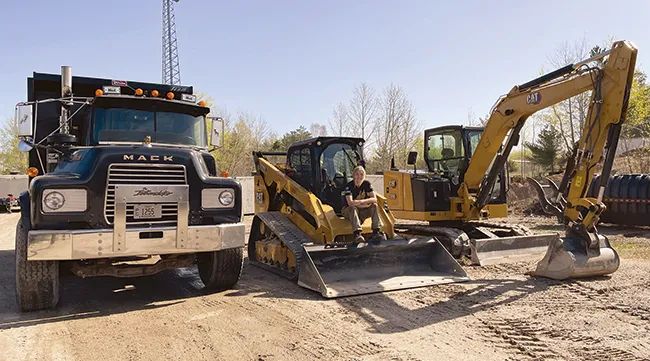
Isabella Johnson works with heavy machinery and earned her CDL for more career flexibility.
Isabella Johnson, 18, recently earned her CDL and works at Concrete Products in Rhinelander, Wis. She doesn’t plan to work in over-the-road trucking right now but might someday and thought a CDL would give her flexibility.
“I work with big machinery, and I wanted to be able to haul whatever I wanted whenever I needed,” she said.
Emphasizing Culture
Company culture is essential to attracting and retaining drivers who want to feel like they are part of a team.
“They deserve information about what is happening, changes that are coming, and how the company is doing,” ODFL’s Cox said. “Sometimes, I think that aspect can be overlooked as we get caught up in the day-to-day, but it is essential drivers know what is going on with the company and know they play a crucial role in its success.”
Brenny has found that younger workers are tired of hierarchies.
“I’m not saying they shouldn’t earn their stripes, but they want it known that they have a voice and are part of the team,” she said.
Many members of Gen Z also seek out opportunities to give back to society.
Brenny Transportation taps into that with its “Haul of Fame,” which highlights essential products the company has hauled.
“We talk about the difference they’re making and the lives that they are making better,” Brenny said. “Talking about those things is inspiring, and they need to have that sense of purpose and how important their job is.”
Want more news? Listen to today's daily briefing below or go here for more info:





